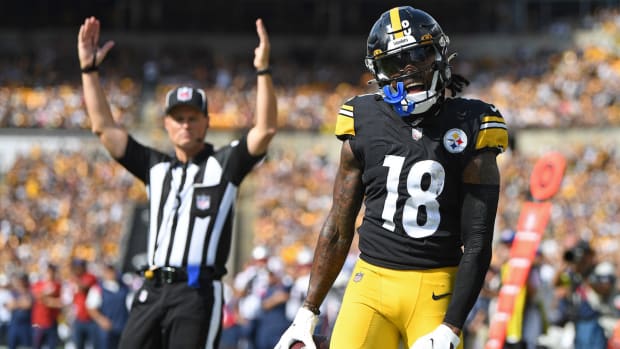Is It Time to Talk Super Bowl for Deshaun Watson's Texans?
The Texans’ league-best nine-game winning streak has not necessarily gone unnoticed, but it’s been quiet enough that any mention of this team’s contention for a postseason bye—and, therefore, a Super Bowl run—brings a subtle jolt of surprise. At 9-3, the Texans are currently the No. 3 seed in the AFC (tied with the Patriots—Houston loses the tiebreaker due to a season-opening loss in New England—and a game behind the Chiefs). Can they make a run in January?
Houston’s defense is more than capable. Up front, J.J. Watt looks like his old self, Jadeveon Clowney has dominated playing more reps inside where his explosiveness is maximized, and linebacker Zach Cunningham is operating with the athleticism that made him a 2017 second-round pick. (Cunningham had some tremendous snaps in zone coverage against the Browns on Sunday, including a pick-six.) On the back end, Tyrann Mathieu is also looking like his old self, Aaron Colvin’s return from an ankle injury aids the cornerbacking depth and third-round rookie safety Justin Reid, who had his best NFL game on Sunday, has played with more range and physicality each week.
On offense, the Texans are not quite electrifying, but the supporting cast is sturdy enough for this unit to properly complement a top-level defense. Offensive line coach Mike Devlin has worked wonders with what initially was a callow, makeshift front five. It’s becoming not just dependable in pass protection, but imposing on the ground. It helps that they’re blocking for a disciplined, highly professional running duo in Lamar Miller and Alfred Blue—those two are averaging a combined 167 yards a game over the last three weeks. Through the air, DeAndre Hopkins catches whatever you throw him, which can offset the rest of the receiving corps’ mediocrity.
If you want the latest episode of The Monday Morning NFL Podcast in your feed when you wake up Monday morning, then subscribe to The MMQB Podcasts. (For non-subscribers, there is typically a lag.)
This leaves only the quarterback to examine, and fittingly so. Even the Texans themselves would admit they can only go as far as Deshaun Watson takes them. In the win over Cleveland, Watson looked every bit like an ascending superstar. He appropriately used his legs, not just to scramble but also create new throws. He hit Hopkins in a few tight windows outside. He kept his eyes downfield, looking for the big plays that, much to his coaches’ pleasure, are always at the front of his mind. And, maybe most encouraging, for the fifth time in six weeks, he avoided turnovers, in this case against a Browns D that changed coverages from snap to snap and brought a bevy of different blitzes, many up the middle.
If this is the Deshaun Watson the Texans have moving forward, they’re a full-fledged Super Bowl contender. But there are also the unripe parts of Watson that many outside the NFL don’t notice, but that those within absolutely do. That Watson can hold the Texans back.
KAHLER:How It All Went Wrong in Packerland
Last season, O’Brien hid the unripe Watson by merging his traditional NFL offense with a college-style system. The Texans featured an array of pre-snap motion, misdirection designs, read-option looks and jet sweeps. This year, O’Brien, a venerated schemer, has mostly gone back to his old approach. No offense except Seattle’s has run the ball on first down as much as Houston, and few offenses commit so regularly to six- and seven-man pass protections. This propagates deeper dropbacks and more downfield throws.
Run-first play-calling with a deeper passing game is old school football, and for it to work, your quarterback must be willing to play from within the pocket. Most of the time, Watson does. But this season, there have been significant snaps where he has impatiently broken himself down early.
This is not uncommon with young QBs, especially mobile ones. It can be a hard habit to break, particularly for Watson, who has always been able to run away from defenders. To Watson’s credit, since Day One of his career he has been mostly willing to forego a runner’s mindset and has strived to work through all his progressions on-schedule. But since improving here each week as a rookie, his pocket discipline in Year Two has been a little spottier. And those bouts of youthful quarterbacking carry greater punishment in O’Brien’s more traditional offense. When Watson gets frenetic, his field reading wavers. Like most young QBs, Watson sometimes isn’t quick enough to eliminate covered reads, and he doesn’t quite have an innate feel for how his backside reads relate to the coverage he’s seeing. But this starts with his feet, as much as anything. The less Watson moves in the pocket, the better he sees downfield.
This isn’t to say Watson shouldn’t move. An asset as powerful as his legs must be used—but only as a Plan B, rarely a Plan A. In the NFL, where you’re facing fast, complex defenses that each week are tailored to stop you, sustained success can come only from being a passer first and a runner second. How effectively Watson finds this balance down the stretch will decide how far the Texans go.
• Question or comment? Email us at talkback@themmqb.com.




































